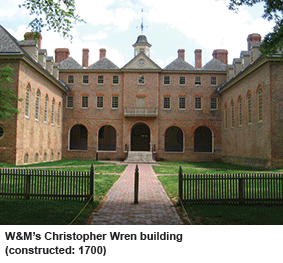The second oldest higher education institution in the US, College of William & Mary, USA is ranked among the Top 10 publicly-funded universities of America: Summiya Yasmeen
 Chartered in 1693 by King William III and Queen Mary II of England, the College of William & Mary, USA (W&M) is the second oldest higher education institution (after Harvard) in the US and a top-ranked public university in its own right. One of the original eight ‘Public Ivies’, College of William & Mary, USA is ranked #34 by the US News & World Report in its 2016 rankings of Best National Universities and among the Top 10 public varsities of America. In its 2015 America’s Top Colleges rankings, Forbes ranks W&M #6 among public varsities and #39 of the 650 best private and public colleges and universities in the US.
Chartered in 1693 by King William III and Queen Mary II of England, the College of William & Mary, USA (W&M) is the second oldest higher education institution (after Harvard) in the US and a top-ranked public university in its own right. One of the original eight ‘Public Ivies’, College of William & Mary, USA is ranked #34 by the US News & World Report in its 2016 rankings of Best National Universities and among the Top 10 public varsities of America. In its 2015 America’s Top Colleges rankings, Forbes ranks W&M #6 among public varsities and #39 of the 650 best private and public colleges and universities in the US.
Currently, the university’s faculty of arts and sciences and four graduate schools — education, law, business and marine science — offer 40 undergraduate and 20 graduate programmes to 8,484 students mentored by 624 full-time faculty. W&M is highly regarded for its rigorous liberal arts undergrad curriculum which mandates original hands-on research that transforms into independent or faculty-mentored research projects. The college’s distinctive liberal arts General Education Requirements (GER) curriculum requires all undergrad students to complete courses in mathematics and quantitative reasoning, natural and social sciences, world cultures and history, literature and history of the arts, creative and performing arts and philosophical, religious, and social thought.
Over its 323-year history, College of William & Mary, USA has graduated several distinguished alumni including three US presidents — Thomas Jefferson, James Monroe and John Tyler — as well as former secretary of defence Robert Gates, actress Glenn Close and comedians Jon Stewart and Patton Oswalt.
Williamsburg. Sited in Virginia state, 150 miles south of Washington D.C, Williamsburg (pop.14,691) is a modern town steeped in history. Formerly the capital of Virginia, Williamsburg together with neighbouring Jamestown and Yorktown, form the Historic Triangle, which attracts more than four million tourists annually. The historic area, Colonial Williamsburg, is a 301-acre living-history museum featuring buildings from the 17th-19th centuries. Beyond the historical theme park, Williamsburg is a lively college and tourist town with over 100 restaurants, live music clubs, art galleries, movie theatres and other entertainment venues. The sunny shores of Virginia Beach and the big city life of Richmond and Washington D.C. are a mere three-four hour drive.
The weather in Williamsburg is temperate year-round with cool to mild winters, and hot, humid summers. Average temperatures in winter range from 9.8°C to -0.3°C and in summer from 20.7°C to 30.7°C.
Campus facilities. Sited in historic downtown Williamsburg, the 1,200-acre college campus features state-of-the-art academic buildings, residences, sports facilities, the scenic Lake Matoaka and the College Woods. The campus’ Sir Christopher Wren Building (1700) is the oldest university building still in use in the US. Other campus landmarks include the $57-million Integrated Science Center (biology, chemistry and psychology labs with cutting-edge research facilities), Muscarelle Museum of Art (collection of nearly 5,000 paintings, sculptures), open-air Lake Matoaka Amphitheatre, Campus Center and Sadler Center (conference rooms, dining facilities). The college’s Earl Gregg Swem Library houses a collection of more than 2 million books, journals, government documents and films, and a Special Collections Research Center.
Sports facilities are extensive and include a multi-purpose field (rugby and soccer), McCormack-Nagelsen Tennis Center, and the Student Recreation Center featuring three gyms, a 25-yard eight-lane pool, a state-of-the-art fitness center, an indoor climbing wall and juice bar. Over 400 student clubs and organisations on campus host social and cultural activities year round.
A second 42-acre campus (Gloucester Point) is sited at the mouth of River York and hosts the Virginia Institute of Marine Science.
Admission. Admission into College of William & Mary is very selective. Last year of the 15,000 students who applied for admission into its undergrad programmes, only 1,500 were chosen. The minimum eligibility requirement for admission into College of William & Mary’s undergraduate programmes is successful completion of Plus Two. In addition, students must submit test scores of SAT I or ACT and TOEFL or IELTS exams. The completed common application form (www.commonapp.org) plus a $70 fee must be submitted together with secondary school reports, teacher evaluation form and recommendation letter, personal statement and extra-curricular activities record. The application deadline is November 1 for early decision applicants and January 1 for regular admission freshman applicants.
For further information, contact The College of William & Mary, Office of Undergraduate Admission, P.O. Box 8795, Williamsburg, VA 23187-8795. Ph: +1 757 221 4223; Fax: +1 757 221 1242; e-mail: [email protected] or [email protected]; website: www.wm.edu.
Accommodation. Nearly three-fourths of undergrad students live on campus. First-year students start in one of 14 co-ed residence halls featuring study lounges, social areas, laundry facilities, and shared kitchens. Other on-campus residential options include Jamestown North and South (shared kitchens and lounges on every floor); Tribe Square (14 apartments); One Tribe Place (en suite rooms) and fraternity housing (12 buildings).
Degree programmes. The faculty of arts and sciences and four graduate/professional schools offer over 40 undergraduate programmes plus 20 graduate and professional degree programmes (see box).
| SCHOLASTIC OPTIONS AT WILLIAM & MARY
The College of William & Mary offers a wide range of undergrad and postgraduate degrees across five faculties. They include: |



























